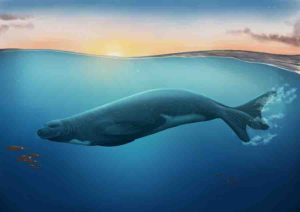
The discovery, published today in the Proceedings of the Royal Society, radically changes scientists’ understanding of how seal species evolved around the world.
It came after researchers examined seven preserved fossil specimens, including a complete skull, found by local fossil hunters on south Taranaki beaches in New Zealand between 2009 and 2016.
The new species is named Eomonachus belegaerensis, (meaning ‘dawn monk seal from Belegaer’) after the sea of Belegaer, which lies west of Middle Earth in J.R.R. Tolkien’s Lord of the Rings.
Around 2.5 metres in length and weighing around 200 — 250kg, Eomonachus belegaerensis lived in the waters around New Zealand some 3 million years ago.
It was previously thought that all true seals originated in the North Atlantic, with some later crossing the equator to live as far south as Antarctica.
Eomonachus now shows that many ancient seals, including the ancestors of today’s monk, elephant and Antarctic seals, actually evolved in the Southern Hemisphere.
Monash palaeontologist James Rule, a PhD candidate at the Biomedicine Discovery Institute, led the research as part of a trans-Tasman collaboration involving Monash University and Museums Victoria in Australia, and Te Papa and Canterbury Museum in New Zealand. The study was supervised and co-authored by Dr Justin Adams (Monash Biomedicine Discovery Institute), Dr Erich Fitzgerald (Museums Victoria), and Associate Professor Alistair Evans (School of Biological Sciences).
“This new species of extinct monk seal is the first of its kind from the Southern Hemisphere. Its discovery really turns seal evolution on its head,” Mr Rule said.
“Until now, we thought that all true seals originated in the Northern Hemisphere, and then crossed the equator just once or twice during their entire evolutionary history. Instead, many of them appear to have evolved in the southern Pacific, and then criss-crossed the equator up to eight times.”
Te Papa Museum of New Zealand curator of marine mammals and study collaborator Dr Felix Marx said the discovery was a triumph for citizen science.
“This new species has been discovered thanks to numerous, exceptionally well-preserved fossils — all of which were found by members of the public.”
Dr Marx is hopeful about future discoveries of new species in New Zealand’s ancient past.
“New Zealand is incredibly rich in fossils, and so far we have barely scratched the surface. Who knows what else is out there?” Dr Marx said.
About monk seals. Unlike their cold-loving relatives in the Arctic and Antarctic, Monk seals prefer the warmer waters of the Mediterranean, Hawai’i and — until their extinction there in the 1950s — the Caribbean. Monk seals are the most endangered groups of marine mammals, with fewer than 2000 individuals thought to be left in the wild. Hunting has driven populations down.
Reference:
James P. Rule, Justin W. Adams, Felix G. Marx, Alistair R. Evans, Alan J. D. Tennyson, R. Paul Scofield, Erich M. G. Fitzgerald. First monk seal from the Southern Hemisphere rewrites the evolutionary history of true seals. Proceedings of the Royal Society B: Biological Sciences, 2020; 287 (1938): 20202318 DOI: 10.1098/rspb.2020.2318
Note: The above post is reprinted from materials provided by Monash University.










